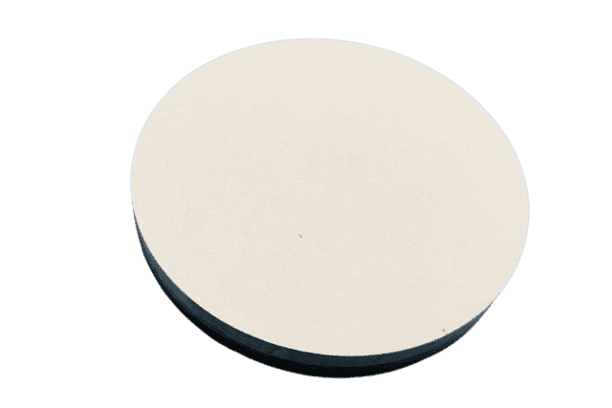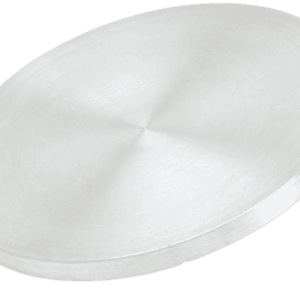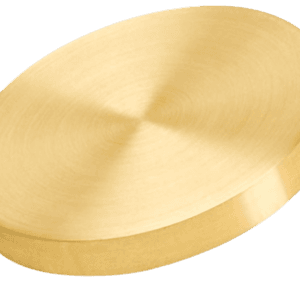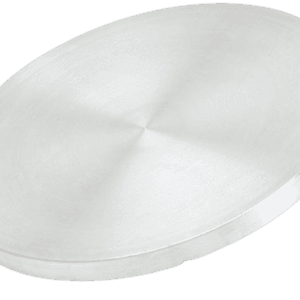| Material Type | Calcium Titanate |
| Symbol | CaTiO3 |
| Color/Appearance | White/off-white, Solid |
| Melting Point (°C) | 1,975 |
| Relative Density (g/cc) | 3.98 @ 25°C |
| Z Ratio | N/A |
| Sputter | RF, DC |
| Max Power Density* (Watts/Square Inch) | |
| Type of Bond | Indium, Elastomer |
| Comments | Disproportionates except in sputtering. |
Calcium Titanate Sputtering Targets
Calcium Titanate (CaTiO₃) sputtering targets are high-purity materials used in the production of thin films for advanced applications in semiconductor, electronic, and optics industries. Known for their unique properties, these targets are often used to create dielectric materials and coatings with excellent stability and performance.
Specifications
- Purity: 99.9%
- Circular Targets: Diameter ≤ 14 inches, Thickness ≥ 1mm
- Block Targets: Length ≤ 32 inches, Width ≤ 12 inches, Thickness ≥ 1mm
Key Features and Advantages
- High Purity: TFM’s Calcium Titanate sputtering targets are made with a purity of 99.9%, ensuring the production of high-quality thin films with reliable and consistent properties.
- Custom Sizes Available: These targets are available in custom sizes to meet the specific requirements of both R&D and large-scale production applications.
- Dielectric Properties: Calcium Titanate is well known for its high dielectric constant and is frequently used in the production of capacitors, making it ideal for electronics and semiconductor applications.
- Excellent Stability: The material provides excellent stability over a range of temperatures and is chemically inert, making it suitable for use in harsh environments.
- Vacuum Compatibility: These targets are carefully cleaned and packaged to be compatible with vacuum deposition systems, ensuring protection from contamination and maintaining the integrity of the thin films produced.
Applications
- Semiconductor Industry: Calcium Titanate thin films are used in semiconductor devices to enhance performance, particularly in the formation of capacitors and other dielectric components.
- Dielectric Materials: With its high dielectric constant, Calcium Titanate is used to produce thin films for capacitors, insulators, and other dielectric applications in electronics.
- Optics: Calcium Titanate is used in the optics industry for coatings that require stable dielectric properties, such as antireflection coatings and optical devices.
- Energy Storage: The material’s dielectric properties make it a strong candidate for use in energy storage devices, particularly in high-performance capacitors and supercapacitors.
- Ferroelectrics: Calcium Titanate is also used in ferroelectric applications, making it suitable for memory devices and other specialized components in advanced electronics.
Manufacturing Process
- Cold-Pressed and Sintered: The Calcium Titanate sputtering targets are cold-pressed and sintered to achieve high density and uniformity, ensuring efficient deposition with consistent performance.
- Elastomer Bonding: The targets are elastomer bonded to the backing plate to improve durability and performance during the sputtering process.
- Cleaning and Packaging: All targets are carefully cleaned and packaged to protect them from contamination, ensuring they are ready for use in vacuum deposition systems.
Available Options
- 99.9% Purity: TFM’s Calcium Titanate sputtering targets have a 99.9% purity to ensure the production of high-quality thin films for critical applications.
- Custom Sizes: Available in custom sizes for both large-scale production and R&D purposes, offering flexibility to meet specific application needs.
- R&D Applications: Smaller sizes of Calcium Titanate sputtering targets are available for research and development (R&D) purposes, allowing experimentation and prototyping.
- Sputtering Target Bonding Service: TFM offers a sputtering target bonding service to secure the target to the backing plate for enhanced performance.
Conclusion
TFM’s Calcium Titanate Sputtering Targets are ideal for applications in semiconductors, electronics, and optics. With their high purity, customizable sizes, and reliable manufacturing process, these targets offer excellent dielectric properties and stability for producing high-quality thin films. Whether used in research, development, or industrial production, Calcium Titanate sputtering targets from TFM provide consistent and dependable results for a wide range of advanced technologies.





Reviews
There are no reviews yet.